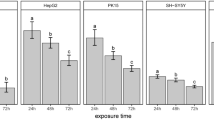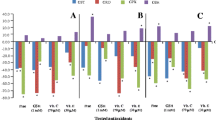Abstract
Previous work in our laboratory led to the isolation of a cadmium (Cd)-resistant variant (Cdr2C10) of the line CHO Chinese Hamster cell having a 10-fold greater resistance to the cytotoxic action of Cd2+ compared with the CHO cell. This resistance was attributed to an increased capacity of the Cd2+-resistant Cdr2C10 subline to induce synthesis of the Cd2+- and Zn2+-binding protein(s), metallothionein(s) (MT). Evidence that Cd2+ behaves as an analog of the essential trace metal, Zn2+, especially as an inducer of MT synthesis, suggested that the Cdr and CHO cell types could be employed to investigate cellular Zn2+ metabolism. In the present study, measurements were made to compare CHO and Cdr cell types for (a) growth as a function of the level of ZnCl2 added to the culture medium, (b) uptake and subcellular distribution of Zn2+, and (c) capacity to induce MT synthesis. The results of these measurements indicated that (a) both CHO and Cdr cell types grew normally (T d≊16–18 h) during exposures to Zn2+ at levels up to 100 μM added to the growth medium, but displayed abrupt growth inhibition at higher Zn2+ levels, (b) Cdr cells incorporate fourfold more Zn2+ during a 24-h exposure to the maximal subtoxic level of Zn2+ and (c) the CHO cell lacks the capacity to induce MT synethesis while the Cdr cell is proficient in this response during exposure to the maximal subtoxic Zn2+ level. These findings suggest that (a) the CHO and Cdr cell systems will be useful in further studies of cellular Zn2+ metabolism, especially in comparisons of Zn2+ metabolism in the presence and absence of induction of the Zn2+-sequestering MT and (b) a relationship exists between cellular capacity to induce MT synthesis and capacity for cellular Zn2+ uptake.
Similar content being viewed by others
References
W. R. Todd, C. A. Elvehjem, and E. B. Hart,Am. J. Physiol. 107 146 (1934).
B. L. Vallee, inAspects Biological of Inorganic Chemistry, A. W. Addison, W. R. Cullen, D. Dolphin, and B. R. James, eds., Wiley, New York, NY, 1977, pp. 37–70.
A. S. Prasad and D. Oberleas, eds.,Trace Elements in Human Health and Disease: Zinc and Copper, vol. 1, Academic Press, New York, 1976.
R. J. Cousins,Am. J. Clin. Nutr. 32, 339 (1979).
A. S. Prasad,Ann. Rev. Pharmacol. Toxicol. 20, 393 (1979).
R. P. Cox,Mol. Pharmacol. 4, 510 (1968).
R. P. Cox,Science 165 196 (1969).
R. P. Cox and A. Ruckenstein,J. Cell. Physiol. 77, 71 (1971).
M. L. Failla and R. J. Cousins,Biochim. Biophys. Acta 538, 435 (1978).
M. L. Failla and R. J. Cousins,Biochim. Biophys. Acta 543, 293 (1978).
C. J. Rudd and H. R. Herschman,Toxicol. Appl. Pharmacol. 47, 273 (1979).
C. E. Hildebrand, R. A. Tobey, E. W. Campbell, and M. D. Enger,Exptl. Cell Res,124, 237–246 (1979).
B. L. Vallee and D. D. Ulmer,Ann. Rev. Biochim. 41, 91 (1972).
F. Kao and T. T. Puck,Genetics 79, 343 (1975).
E. H. Y. Chu and S. S. Powell, inAdvances in Human Genetics, H. Harns and K. Hirschhorn, eds., vol. 7, 1976, p. 189.
J. P. O'Neill, P. A. Brimer, R. Machanoff, G. P. Hirsch, and A. W. Hsie,Mut. Res. 45, 91 (1977).
Y. Kojima and J. H. R. Kägi,Trends in Biochem. Sci. 3, 90 (1978).
M. G. Cherian and R. A. Goyer,Life Sci. 23, 1 (1978).
M. D. Enger, E. W. Campbell, R. L. Ratliff, R. A. Tobey, C. E. Hildebrand, and R. J. Kissane,J. Toxicol. Environ. Health 5, 711 (1979).
M. D. Enger, C. E. Hildebrand, M. Jones, and H. L. Barrington, inDevelopmental Toxicology of Energy-Related Pollutants, Proceedings of the 17th Annual Hanford Biology Symposium, D. D. Hahlum, M. R. Sikov, P. L. Hackett, and F. D. Andrew, eds., National Technical Information Center, Springfield, VA, 1978, pp. 37–56.
M. P. Richards and R. J. Cousins,Bioinorg. Chem. 4, 215 (1975).
P. C. Huang, B. Smith, P. Bohdan, and A. Corrigan,Biol. Trace Element Res. 2, 211 (1980).
M. Karin and H. R. Herschman,Science 204 176 (1979).
K. R. Etzel, S. G. Shapiro, and R. J. Cousins,Biochem. Biophys. Res. Commun. 89, 1120 (1979).
Author information
Authors and Affiliations
Rights and permissions
About this article
Cite this article
Hildebrand, C.E., Enger, M.D. & Tobey, R.A. Comparative studies of zinc metabolism in cultured chinese hamster cells with differing metallothionein-induction capacities. Biol Trace Elem Res 2, 235–246 (1980). https://doi.org/10.1007/BF02783822
Received:
Accepted:
Issue Date:
DOI: https://doi.org/10.1007/BF02783822




